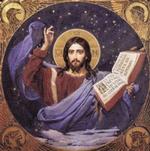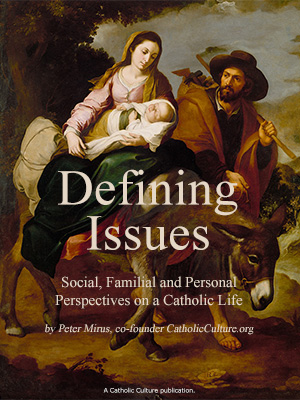The New IGMR And Mass Versus Populum
by Christopher M. Cullen, Joseph W. Koterski
Recent news reports about the new General Instruction to the Roman Missal seem to imply at one point that celebration of the Mass versus populum is desirable whenever possible and that celebration ad orientem is somehow undesirable. Now a close look at the actual Latin text of the relevant passage does indicate a certain ambiguity. The phrase "which is desirable whenever possible" that has been added in the new version of the General Instruction could apply either to the placement of the altar or to the manner of celebration. But the context of the passage in which the phrase in question appears actually makes clear that what the document is asserting to be desirable is not the practice of celebrating the Mass facing the people whenever possible but the provision for a free-standing altar at which such celebration is possible.
In the rush to provide instant interpretation of the new edition of the General Instruction, however, many accounts have been quick to presume that the phrase "which is desirable whenever possible" refers to the direction in which the priest is to face at the altar. For example, the National Catholic Reporter (August 25, 2000) said: "Recent comments by Cardinal Joseph Ratzinger notwithstanding, the new instruction endorses the post-Vatican II practice of priests facing their congregations while celebrating Mass."
NCR went on to explain: "On the priest's stance, the 1975 instruction said that altars 'should be free-standing to allow the ministers to walk around it easily and Mass to be celebrated facing the people.' The new document maintains that language, and adds, 'which is desirable whenever possible.'"
But this interpretation of the phrase in question latches onto one of the two possibilities without even noticing the ambiguity and thus without considering which of the alternatives is actually more probably the correct one. Here is the Latin text and a literal translation:
299. Altare maius exstruatur a pariete seiunctum, ut facile circumiri et in eo celebratio versus populum peragi possit, quod expedit ubicumque possibile sit. Altare eum autem occupet locum, ut revera centrum sit ad quod totius congregationis fidelium attentio sponte convertatur. De more sit fixum et dedicatum.
299. Let the main altar be erected separate from the wall so that one can easily walk around it and at it celebration towards the people can be done — which is useful wherever possible. But this altar should occupy that place such that it is truly the center, to which the attention of the whole congregation of the faithful is spontaneously directed. Ordinarily it should be fixed and consecrated.
Since this is the passage that contains the words on which so much attention is being directed, great care is needed to ascertain the antecedent to which the quod clause refers as well as to provide the most suitable translation. Even to translate expedit as "desirable" may be saying a bit too much, so we suggest the more neutral term "useful." Now, at first glance, it might well seem that the whole clause quod expedit ubicumque possibile sit ("which is useful wherever possible") applies to the phrase "at it celebration towards the people can be done" — as if this were suggesting that Mass should be celebrated facing the people wherever possible. But, the alternative possibility is to take the clause "which is useful wherever possible" as referring to the provision of a freestanding altar, and in fact this is the more likely rendering precisely because this entire section concerns the disposition of the altar. It is not the section concerned with the actions of the Mass.
The specific context in which this passage occurs is a subsection that runs from number 296 to 308 concerning the altar and its decoration. Paragraph 309 deals with the ambo while paragraph 310 concerns the chair of the priest and other seats in the sanctuary. The larger section (##295-310) within Chapter 5 of the document, within which this subsection appears, is entitled "On the arrangement of the sanctuary for the sacred synaxis" (De presbyterii ordinatio ad sacram synaxim). As an aside, the very choice of words here is extremely interesting, for the word used for "sanctuary" is presbyterium (the place of priests). But with respect to the point in question, it is most important to note that the phrase occurs in a discussion of the altar that falls within a discussion of the arrangement of the sanctuary and not in a discussion of the actions of the Mass.
It may be helpful to remember the larger context in which this passage occurs. While Chapter 5 in general is on the arrangement of the church for the celebration of Mass, it is Chapter 4, which is concerned with the diverse ways of celebrating Mass (for instance, with and without a congregation, with and without a deacon, etc.). The point in question is whether the phrase "which is desirable (useful) wherever possible" refers to the preferred way of celebrating the Mass or to the provision of a freestanding altar. But Chapter 4 does not anywhere say that it is desirable whenever possible to celebrate Mass facing the people and, in fact, seems to presuppose the opposite.
Further indication that the quod clause in paragraph 299 does not mean to imply that celebration versus populum is "desirable whenever possible" is found in Chapter 4, which concerns the different forms of celebrating Mass. Throughout the section of that chapter on Mass cum populo there is no explicit statement about whether the priest is facing versus populum or ad orientem, but the presumption seems to be that the priest is turned away from the people for the General Instruction makes a point of clarifying precisely those points in the Mass at which the priest is to turn toward the people. It is difficult to imagine why it would do so unless the priest were not facing the people but needs to turn around in order to do so. One such moment is found in paragraph 146 when the priest, after having completed the lavabo, is directed to return to the middle of the altar and to stand versus populum and to invite the people to prayer, saying Orate fratres. It would make little sense to direct the priest to stand facing the people if he were already facing the people; in that case the phrasing would be redundant.
But this is not the only passage of that sort. In paragraph 157 concerning the exposition of the host to the people just before communion, the priest is again directed to face the people while holding the host above the paten or chalice (note, by the way, a change here from the earlier edition of the General Instruction, which had not mentioned the chalice at this point) as he says "Ecce Agnus Dei." And immediately afterwards in paragraph 158 we find the decisive passage in the moment of the priest's communion: after the people have responded "Domine non sum dignus," the priest is now directed to turn back toward the altar (stans ad altare conversus) and to say silently "Corpus Christi custodiat me in vitam aeternam" and reverently to receive the Body of Christ. The words ad altare conversus only makes sense if the priest was facing away from the altar and toward the people and then has to turn back towards it in order to receive communion.
In short, the various mentions of versus ad populum would be superfluous if the document envisioned this posture as operative throughout the section on the actions of the Mass. Unless we are to suppose that the new General Instruction was written carelessly and still happens to retain the rubrics of the Tridentine rite of the Mass (a charge that was sometimes leveled at the 1970 version of the General Instruction), Chapter 4 must be read as presuming that the posture of the priest is ad orientem and not ad populum. With this in mind, we can feel all the more confident that the phrase "which is desirable (useful) whenever possible" which occurs in Chapter 3 really does refer to the provision for a freestanding altar wherever possible and not the desirability wherever possible of celebrating, versus populum.
Reverend Joseph W. Koterski, S.J., earned his Ph.D. in philosophy at St. Louis University and was ordained in 1992. He has taught at the University of St. Thomas in Houston, Texas, and at Loyola College in Baltimore, Md. At present he is an assistant professor of philosophy at Fordham University, Bronx, N. Y., and is the current editor of the International Philosophical Quarterly.
Reverend Christopher M. Cullen, S.J., last year received his Ph.D. in philosophy from The Catholic University of America. Currently he is an assistant professor of philosophy at Fordham University in Bronx, N. Y. This is his first article in HPR.
This item 3963 digitally provided courtesy of CatholicCulture.org






